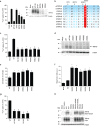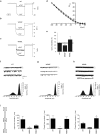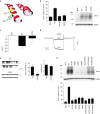A Gate Hinge Controls the Epithelial Calcium Channel TRPV5
- PMID: 28374795
- PMCID: PMC5379628
- DOI: 10.1038/srep45489
A Gate Hinge Controls the Epithelial Calcium Channel TRPV5
Abstract
TRPV5 is unique within the large TRP channel family for displaying a high Ca2+ selectivity together with Ca2+-dependent inactivation. Our study aims to uncover novel insights into channel gating through in-depth structure-function analysis. We identify an exceptional tryptophan (W583) at the terminus of the intracellular pore that is unique for TRPV5 (and TRPV6). A combination of site-directed mutagenesis, biochemical and electrophysiological analysis, together with homology modeling, demonstrates that W583 is part of the gate for Ca2+ permeation. The W583 mutants show increased cell death due to profoundly enhanced Ca2+ influx, resulting from altered channel function. A glycine residue above W583 might act as flexible linker to rearrange the tryptophan gate. Furthermore, we hypothesize functional crosstalk between the pore region and carboxy terminus, involved in Ca2+-calmodulin-mediated inactivation. This study proposes a unique channel gating mechanism and delivers detailed molecular insight into the Ca2+ permeation pathway that can be extrapolated to other Ca2+-selective channels.
Conflict of interest statement
The authors declare no competing financial interests.
Figures





Similar articles
-
Molecular mechanisms of calmodulin action on TRPV5 and modulation by parathyroid hormone.Mol Cell Biol. 2011 Jul;31(14):2845-53. doi: 10.1128/MCB.01319-10. Epub 2011 May 16. Mol Cell Biol. 2011. PMID: 21576356 Free PMC article.
-
Determining the Crystal Structure of TRPV6.In: Kozak JA, Putney JW Jr, editors. Calcium Entry Channels in Non-Excitable Cells. Boca Raton (FL): CRC Press/Taylor & Francis; 2018. Chapter 14. In: Kozak JA, Putney JW Jr, editors. Calcium Entry Channels in Non-Excitable Cells. Boca Raton (FL): CRC Press/Taylor & Francis; 2018. Chapter 14. PMID: 30299652 Free Books & Documents. Review.
-
Regulation of the mouse epithelial Ca2(+) channel TRPV6 by the Ca(2+)-sensor calmodulin.J Biol Chem. 2004 Jul 9;279(28):28855-61. doi: 10.1074/jbc.M313637200. Epub 2004 Apr 30. J Biol Chem. 2004. PMID: 15123711
-
Modeling the structural and dynamical changes of the epithelial calcium channel TRPV5 caused by the A563T variation based on the structure of TRPV6.J Biomol Struct Dyn. 2019 Aug;37(13):3506-3512. doi: 10.1080/07391102.2018.1518790. Epub 2018 Dec 10. J Biomol Struct Dyn. 2019. PMID: 30175942 Free PMC article.
-
Structure and function of the calcium-selective TRP channel TRPV6.J Physiol. 2021 May;599(10):2673-2697. doi: 10.1113/JP279024. Epub 2020 Mar 13. J Physiol. 2021. PMID: 32073143 Free PMC article. Review.
Cited by
-
Mechanism of calmodulin inactivation of the calcium-selective TRP channel TRPV6.Sci Adv. 2018 Aug 15;4(8):eaau6088. doi: 10.1126/sciadv.aau6088. eCollection 2018 Aug. Sci Adv. 2018. PMID: 30116787 Free PMC article.
-
Hydrophobic gating in bundle-crossing ion channels: a case study of TRPV4.Commun Biol. 2023 Oct 27;6(1):1094. doi: 10.1038/s42003-023-05471-0. Commun Biol. 2023. PMID: 37891195 Free PMC article.
-
High-resolution structures of transient receptor potential vanilloid channels: Unveiling a functionally diverse group of ion channels.Protein Sci. 2020 Jul;29(7):1569-1580. doi: 10.1002/pro.3861. Epub 2020 Apr 11. Protein Sci. 2020. PMID: 32232875 Free PMC article. Review.
-
Structural insight into TRPV5 channel function and modulation.Proc Natl Acad Sci U S A. 2019 Apr 30;116(18):8869-8878. doi: 10.1073/pnas.1820323116. Epub 2019 Apr 11. Proc Natl Acad Sci U S A. 2019. PMID: 30975749 Free PMC article.
-
Atomistic Insights of Calmodulin Gating of Complete Ion Channels.Int J Mol Sci. 2020 Feb 14;21(4):1285. doi: 10.3390/ijms21041285. Int J Mol Sci. 2020. PMID: 32075037 Free PMC article. Review.
References
-
- Nilius B. & Voets T. TRP channels: a TR(I)P through a world of multifunctional cation channels. Pflugers Arch. 451, 1–10 (2005). - PubMed
-
- Ramsey I. S., Delling M. & Clapham D. E. An introduction to TRP channels. Annu. Rev. Physiol. 68, 619–647 (2006). - PubMed
-
- Stock L., Souza C. & Treptow W. Structural basis for activation of voltage-gated cation channels. Biochemistry 52, 1501–1513 (2013). - PubMed
-
- Hoenderop J. G. J. & Bindels R. J. M. Calciotropic and magnesiotropic TRP channels. Physiology (Bethesda) 23, 32–40 (2008). - PubMed
Publication types
MeSH terms
Substances
LinkOut - more resources
Full Text Sources
Other Literature Sources
Miscellaneous

